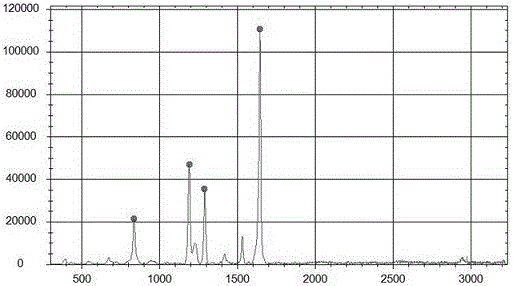Method for rapidly detecting paraquat by utilizing Raman spectrometry
A technology of Raman spectroscopy and paraquat, which is applied in Raman scattering, measuring devices, and material analysis through optical means, and can solve problems such as cumbersome, photochemical reaction interference detection, and detection interference.
- Summary
- Abstract
- Description
- Claims
- Application Information
AI Technical Summary
Problems solved by technology
Method used
Image
Examples
Embodiment 1
[0016] Example 1. Determination of the content of paraquat in wastewater. details as follows.
[0017] (1) Prepare paraquat standard solution: Accurately weigh 0.010 g of paraquat standard product, dissolve it in water, dilute it to 100 mL, store it in the dark at 4 ℃, and dilute the standard solution to 5 μg / kg, 50 μg / kg, and 250 μg respectively / kg, 500μg / kg, 1000μg / kg, 2000μg / kg series of standard solutions for use.
[0018] (2) Preparation of the sample solution to be tested: take 2mL of waste water and filter it with a 0.45μm microporous membrane.
[0019] (3) Draw a standard curve and measure samples: set the laser power of the Raman spectrometer with a wavelength of 785 nm to 100 mW, an integration time of 1 s, an average of 2 times, a smoothing parameter of 5, and a scanning range of 300 to 4500 cm -1 . For each standard solution, add 1 volume of silver nanoparticle sol and 4 volumes of standard solution to a 1 cm optical glass cuvette quickly and sequentially withi...
Embodiment 2
[0020] Example 2. Determination of whether paraquat is contained in wastewater is as follows.
[0021] (1) Preparation of the sample solution to be tested: Take 2 mL of wastewater and filter it with a 0.45 μm microporous membrane.
[0022] (2) Set the wavelength of the Raman spectrometer to 785 nm, the laser power of the laser is 100 mW, the integration time is 1 s, the average times is 1 time, the smoothing parameter is 5, and the scanning range is 300~4500 cm -1 . Add 1 volume of silver nanoparticle sol and 4 volumes of standard solution to a 1 cm optical glass cuvette quickly and sequentially within 10 s, and place them in the detection chamber of a laser Raman spectrometer for detection. After testing, at 1193, 1292, 1648 cm -1 ±3cm -1 A characteristic peak appears at the position, indicating that the water body to be tested contains paraquat.
Embodiment 3
[0023] Example 3. Determination of the content of paraquat in tomatoes. details as follows.
[0024] (1) Prepare paraquat standard solution: Accurately weigh 0.010 g of paraquat standard product, dissolve it in water, dilute it to 100 mL, store it in the dark at 4 ℃, and dilute the standard solution to 5 μg / kg, 50 μg / kg, and 250 μg respectively / kg, 500μg / kg, 1000μg / kg, 2000μg / kg series of standard solutions for use.
[0025] (2) Preparation of sample solution to be tested: Weigh 2g of tomato sample and 2mL of water, shake and mix, centrifuge at 8000 rpm for 5 minutes, take the supernatant, and filter to obtain the solution to be tested.
[0026] (3) Draw a standard curve and measure samples: set the laser power of the Raman spectrometer with a wavelength of 785 nm to 100 mW, an integration time of 1 s, an average of 2 times, a smoothing parameter of 5, and a scanning range of 300 to 4500 cm -1 . For each standard solution, add 1 volume of silver nanoparticle sol and 4 volu...
PUM
 Login to View More
Login to View More Abstract
Description
Claims
Application Information
 Login to View More
Login to View More - R&D
- Intellectual Property
- Life Sciences
- Materials
- Tech Scout
- Unparalleled Data Quality
- Higher Quality Content
- 60% Fewer Hallucinations
Browse by: Latest US Patents, China's latest patents, Technical Efficacy Thesaurus, Application Domain, Technology Topic, Popular Technical Reports.
© 2025 PatSnap. All rights reserved.Legal|Privacy policy|Modern Slavery Act Transparency Statement|Sitemap|About US| Contact US: help@patsnap.com

